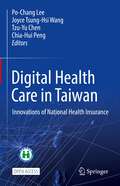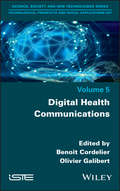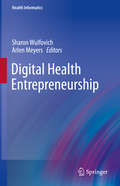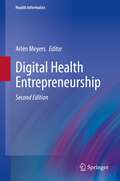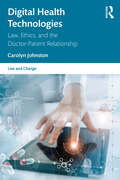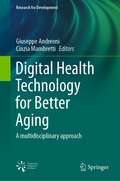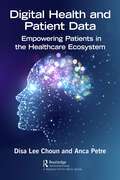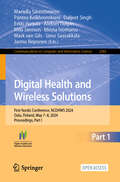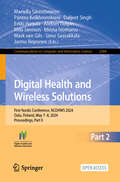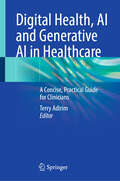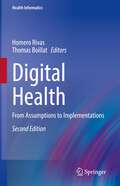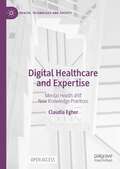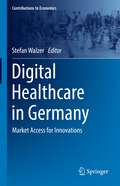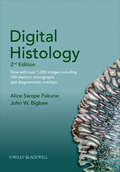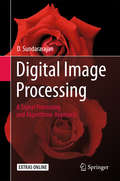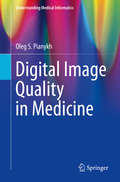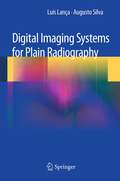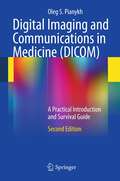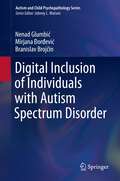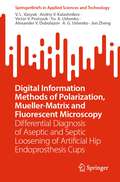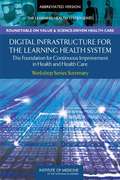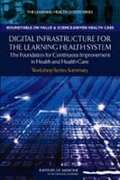- Table View
- List View
Digital Health Care in Taiwan: Innovations of National Health Insurance
by Po-Chang Lee Joyce Tsung-Hsi Wang Tzu-Yu Chen Chia-Hui PengThis open access book introduces the National Health Insurance (NHI) system of Taiwan with a particular emphasis on its application of digital technology to improve healthcare access and quality. The authors explicate how Taiwan integrates its strong Information and Communications Technology (ICT) industry with 5G to construct an information system that facilitates medical information exchange, collects data for planning and research, refines medical claims review procedures and even assists in fighting COVID-19. Taiwan's NHI, launched in 1995, is a single-payer system funded primarily through payroll-based premiums. It covers all citizens and foreign residents with the same comprehensive benefits without the long waiting times seen in other single-payer systems. Though premium rate adjustment and various reforms were carried out in 2010, the NHI finds itself at a crossroads over its financial stability. With the advancement of technologies and an aging population, it faces challenges of expanding coverage to newly developed treatments and diagnosis methods and applying the latest innovations to deliver telemedicine and more patient-centered services. The NHI, like the national health systems of other countries, also needs to address the privacy concerns of the personal health data it collects and the issues regarding opening this data for research or commercial use. In this book, the 12 chapters cover the history, characteristics, current status, innovations and future reform plans of the NHI in the digital era. Topics explored include:Income Strategy Payment StructurePursuing Health EquityInfrastructure of the Medical Information SystemInnovative Applications of the Medical InformationApplications of Big Data and Artificial IntelligenceDigital Health Care in Taiwan is essential reading for academic researchers and students in healthcare administration, health policy, health systems research, and health services delivery, as well as policymakers and public officials in relevant government departments. It also would appeal to academics, practitioners, and other professionals in public health, health sciences, social welfare, and health and biotechnology law.
Digital Health Communications
by Benoit Cordelier Olivier GalibertECHNOLOGICAL PROSPECTS AND SOCIAL APPLICATIONS SET Coordinated by Bruno SalguesThere are many controversies with respect to health crisis management: the search for information on symptoms, misinformation on emerging treatments, massive use of collaborative tools by healthcare professionals, deployment of applications for tracking infected patients. The Covid-19 crisis is a relevant example about the need for research in digital communications in order to understand current health info communication.After an overview of the challenges of digital healthcare, this book offers a critical look at the organizational and professional limits of ICT uses for patients, their caregivers and healthcare professionals. It analyzes the links between ICT and ethics of care, where health communication is part of a global, humanistic and emancipating care for patients and caregivers. It presents new digitized means of communicating health knowledge that reveal, thanks to the Internet, a competition between biomedical expert knowledge and experiential secular knowledge.
Digital Health Entrepreneurship (Health Informatics)
by Sharon Wulfovich Arlen MeyersThis book presents a hands on approach to the digital health innovation and entrepreneurship roadmap for digital health entrepreneurs and medical professionals who are dissatisfied with the existing literature on or are contemplating getting involved in digital health entrepreneurship. Topics covered include regulatory affairs featuring detailed guidance on the legal environment, protecting digital health intellectual property in software, hardware and business processes, financing a digital health start up, cybersecurity best practice, and digital health business model testing for desirability, feasibility, and viability.Digital Health Entrepreneurship is directed to clinicians and other digital health entrepreneurs and stresses an interdisciplinary approach to product development, deployment, dissemination and implementation. It therefore provides an ideal resource for medical professionals across a broad range of disciplines seeking a greater understanding of digital health innovation and entrepreneurship.
Digital Health Entrepreneurship (Health Informatics)
by Arlen MeyersThis extensively revised book is an essential hands-on resource for all involved in digital health innovation and presents an entrepreneurship roadmap for digital health entrepreneurs and medical professionals who are contemplating getting involved. It represents a key resource to maximize the reader's knowledge when investing in this area. Topics covered include regulatory affairs featuring detailed guidance on the legal environment, protecting digital health intellectual property in software, hardware and business processes, financing a digital health start up, cybersecurity best practice and digital health business model testing for desirability, feasibility and viability. Digital Health Entrepreneurship is directed towards clinicians and other digital health entrepreneurs and stresses an interdisciplinary approach to product development, deployment, dissemination and implementation. It therefore provides an ideal resource for medical professionals across a broad range of disciplines seeking a greater understanding of digital health innovation and entrepreneurship.
Digital Health Technologies: Law, Ethics, and the Doctor-Patient Relationship (Law and Change)
by Carolyn JohnstonIncreasingly digital technologies are used in healthcare. This book explores eight digital health technologies, situated the context of a life span, from high-throughput genomic sequencing technologies and do-it-yourself (DIY) insulin delivery for diabetes management in paediatrics, to the use of robotic care assistants for older adults and digital advance care decisions. A scene-setting case scenario at the start of each chapter describes the digital technology and identifies the sometimes competing interests of the key stakeholders. Broad themes of resource allocation, access to technologies, informed consent, privacy of health data and ethical concerns are considered in context, alongside analysis of legal duties owed by healthcare professionals to act in their patients’ best interests. This book addresses legal and ethical issues arising from the use of emerging digital health technologies and is of interest to academics, clinicians and regulators and anyone interested in the development of health technologies and the challenges they may present. It focusses on the Australian legal framework, with some comparison to other jurisdictions.
Digital Health Technology for Better Aging: A multidisciplinary approach (Research for Development)
by Giuseppe Andreoni Cinzia MambrettiThis book describes the multidisciplinary approach needed to tackle better aging. Aging populations are one of the 21st century’s biggest challenges. National health systems are forced to adapt in order to provide adequate and affordable care. Innovation, driven by digital technology, is a key to improving quality of life and encouraging healthy living. Well-designed technology keeps people empowered, independent, and mobile; however, despite widespread adoption of ICT in day-to-day life, digital health technologies have yet to catch on. To this end, technology needs to be effective, usable, cheap, and designed to ensure the security of the managed data. In the era of mHealth, mobile technology, and social design, this book describes, in six sections, the collaboration of polytechnic know-how and social science and health sectors in the creation of a system for encouraging people to engage in healthy behavior and achieve a better quality of life.
Digital Health and Patient Data: Empowering Patients in the Healthcare Ecosystem
by Disa Lee Choun Anca PetrePatients with unmet needs will continue to increase as no viable nor adequate treatment exists. Meanwhile, healthcare systems are struggling to cope with the rise of patients with chronic diseases, the ageing population and the increasing cost of drugs. What if there is a faster and less expensive way to provide better care for patients using the right digital solutions and transforming the growing volumes of health data into insights? The increase of digital health has grown exponentially in the last few years. Why is there a slow uptake of these new digital solutions in the healthcare and pharmaceutical industries? One of the key reasons is that patients are often left out of the innovation process. Their data are used without their knowledge, solutions designed for them are developed without their input and healthcare professionals refuse their expertise. This book explores what it means to empower patients in a digital world and how this empowerment will bridge the gap between science, technology and patients. All these components need to co-exist to bring value not only to the patients themselves but to improve the healthcare ecosystem. Patients have taken matters into their own hands. Some are equipped with the latest wearables and applications, engaged in improving their health using data, empowered to make informed decisions and ultimately are experts in their disease(s). They are the e-patients. The other side of the spectrum are patients with minimal digital literacy but equally willing to donate their data for the purpose of research. Finding the right balance when using digital health solutions becomes as critical as the need to develop a disease-specific solution. For the first time, the authors look at healthcare and technologies through the lens of patients and physicians via surveys and interviews in order to understand their perspective on digital health, analyse the benefits for them, explore how they can actively engage in the innovation process, and identify the threats and opportunities the large volumes of data create by digitizing healthcare. Are patients truly ready to know everything about their health? What is the value of their data? How can other stakeholders join the patient empowerment movement? This unique perspective will help us re-design the future of healthcare - an industry in desperate need for a change.
Digital Health and Wireless Solutions: First Nordic Conference, NCDHWS 2024, Oulu, Finland, May 7–8, 2024, Proceedings, Part I (Communications in Computer and Information Science #2083)
by Daljeet Singh Miia Jansson Mariella Särestöniemi Pantea Keikhosrokiani Erkki Harjula Aleksei Tiulpin Minna Isomursu Mark Van Gils Simo Saarakkala Jarmo ReponenThis two-volume set constitutes the refereed proceedings of the First Nordic Conference on , Digital Health and Wireless Solutions, NCDHWS 2024, held in Oulu, Finland, during May 7–8, 2024. The 51 full papers included in this book together with 7 short papers were carefully reviewed and selected from 100 submissions. They were organized in topical sections as follows: Part I: Remote Care and Health Connectivity Architectures in 6G Era.- User Experience and Citizen Data.- Digitalization in Health Education.- Digital Health Innovations.- Digital Care Pathways. Part II: Clinical Decision Support and Medical AI.- Digital Care Pathways.- Novel Sensors and Bioinformatics.- Health Technology Assessment and Impact Evaluation.- Wireless Technologies and Medical Devices. This book is open access.
Digital Health and Wireless Solutions: First Nordic Conference, NCDHWS 2024, Oulu, Finland, May 7–8, 2024, Proceedings, Part II (Communications in Computer and Information Science #2084)
by Daljeet Singh Miia Jansson Mariella Särestöniemi Pantea Keikhosrokiani Erkki Harjula Aleksei Tiulpin Minna Isomursu Mark Van Gils Simo Saarakkala Jarmo ReponenThis two-volume set constitutes the refereed proceedings of the First Nordic Conference on , Digital Health and Wireless Solutions, NCDHWS 2024, held in Oulu, Finland, during May 7–8, 2024. The 51 full papers included in this book together with 7 short papers were carefully reviewed and selected from 100 submissions. They were organized in topical sections as follows: Part I: Remote Care and Health Connectivity Architectures in 6G Era.- User Experience and Citizen Data.- Digitalization in Health Education.- Digital Health Innovations.- Digital Care Pathways. Part II: Clinical Decision Support and Medical AI.- Digital Care Pathways.- Novel Sensors and Bioinformatics.- Health Technology Assessment and Impact Evaluation.- Wireless Technologies and Medical Devices. This book is open access.
Digital Health in Focus of Predictive, Preventive and Personalised Medicine (Advances in Predictive, Preventive and Personalised Medicine #12)
by Lotfi ChaariThe edition will cover proceedings of the second International conference on digital health Technologies (ICDHT 2019). The conference will address the topic of P4 medicine from the information technology point of view, and will be focused on the following topics: - Artificial Intelligence for health • Knowledge extraction • Decision-aid systems • Data analysis and risk prediction • Machine learning, deep learning - Health data processing • Data preprocessing, cleaning, management and mining • Computer-aided detection • Big data analysis, prediction and prevention • Cognitive algorithms for healthcare handling dynamic context management • Augmented reality, Motion detection and activity recognition - Devices, infrastructure and communication • Wearable & connected devices • Communication infrastructures, architectures and standards Blockchain for e-Health • Computing/storage infrastructures for e-Health • IoT devices & architectures for Smart Healthcare - Health information systems • Telemedicine, Teleservices • Computing/storage infrastructures for e-Health • Clinical Data Visualisation Standards - Security and privacy for e-health • Health data Analytics for Security and Privacy • E-health Software and Hardware Security • Embedded Security for e-health - Applications in P4 medicine </
Digital Health, AI and Generative AI in Healthcare: A Concise, Practical Guide for Clinicians
by Terry AdirimThe purpose of this title is to provide a comprehensive foundation for all medical professionals and healthcare-professions students in understanding Artificial Intelligence (AI). With the advent of generative AI, including the release of Open AI’s ChatGPT in 2022, the world entered a new age of rapid advancements in technology that will significantly change the way clinicians practice medicine, operate healthcare institutions, and conduct research. At the heart of this penetrating book is the idea that medical schools, medical training programs and other health education institutions must undertake a key role in developing AI literacy for clinicians across the spectrum of medical education that includes all health professions. Moreover, assert the authors, AI literacy should be incorporated within medical school curriculums as a core competency, as well as into graduate medical education training programs and continuing medical education courses. This timely and easy-to-read guide offers a wide range of chapters that discuss the core concepts and issues relating to AI in medicine, including a basic understanding of algorithms, machine learning, large language models and natural language processing, the limits and pitfalls of AI, ethical and legal issues, the evolving regulatory landscape around AI, as well as how AI is currently being used in healthcare, to name just several compelling topics. Additionally, AI technologies will change how medical school curriculums are delivered and how student competencies are assessed, maintain the authors. Therefore, medical educators will not only need to rethink how and what medical information is conveyed to students during formal instruction, but also must be prepared for AI-powered programs being used to assess students and trainees for the purpose of licensure and board certification. A timely and soon-to-be gold standard resource in the field, Digital Health, AI, and Generative AI: A Concise, Practical Guide for Clinicians will be of great interest to medical professionals, trainees, administrators, policymakers, and anyone interested in the fast-evolving intersection of digital technologies and healthcare.
Digital Health: A Primer (Analytics and AI for Healthcare)
by Nilmini WickramasingheHealthcare systems globally are grappling with how best to implement effective and efficient patient-centred care while simultaneously trying to contain runaway costs and provide high quality. This book explores the essential enabling role of digital health, taking a socio-technical perspective and looking at the key facets of technology, people and process in turn.This book examines the opportunities of key digital health components, demystifying digital health and demonstrating how to use its key precepts effectively. The book presents evidence and anecdotes from stakeholders around the world, demonstrating the global relevance and the ability of digital health to uplift and upskill care delivery as it is applied commercially. Bridging academic theory and practice, this is a functional and accessible text for all digital health stakeholders.The text introduces critical issues and is suitable reading for students, practitioners and researchers in digital health and all healthcare-related domains.
Digital Health: From Assumptions to Implementations (Health Informatics)
by Homero Rivas Thomas BoillatThis extensively updated second edition describes the increasing use of digital health technologies. It reflects and describes the scenario that healthcare consumers and providers have realized the potential of digital health technologies in light of the recent global healthcare issues, such as the COVID-19 pandemic. Smartphones have become a medical hub through which patients can connect with their medical practitioners and share their vital signs collected through wearables. Concurrently, consumer mobile health apps have shifted from providing generic functionalities to supporting specific diseases such as hypertension, diabetes and cancer. Advancements in digital healthcare have also assisted clinicians, who have relied on artificial intelligence-based applications to support their decision-making. The extent to which digital health has advanced, and is being used by medical professionals and patients, is at the core of this book.Digital Health: From Assumptions to Implementations addresses the emerging trends and enabling tools contributing to technological advances in 21st Century healthcare practice. These areas include generic topics such as mobile health and telemedicine, as well as specific concepts such as social media for health, wearables and quantified-self trends. Also covered are the psychological models leveraged in the design of solutions to persuade us to follow some recommended actions, the design and educational facets of the proposed innovations, as well as ethics, privacy, security and liability aspects influencing its acceptance. Furthermore, sections on economic aspects of the proposed innovations are included, analyzing the potential business models and entrepreneurship opportunities in the domain.
Digital Healthcare and Expertise: Mental Health and New Knowledge Practices (Health, Technology and Society)
by Claudia EgherThis open access book explores how expertise about bipolar disorder is performed on American and French digital platforms by combining insights from STS, medical sociology and media studies. It addresses topical questions, including: How do different stakeholders engage with online technologies to perform expertise about bipolar disorder? How does the use of the internet for processes of knowledge evaluation and production allow for people diagnosed with bipolar disorder to reposition themselves in relation to medical professionals? How do cultural markers shape the online performance of expertise about bipolar disorder? And what individualizing or collectivity-generating effects does the internet have in relation to the performance of expertise? The book constitutes a critical and nuanced intervention into dominant discourses which approach the internet either as a quick technological fix or as a postmodern version of Pandora’s box, sowing distrust among people and threatening unified conceptualizations and organized forms of knowledge.
Digital Healthcare in Germany: Market Access for Innovations (Contributions to Economics)
by Stefan WalzerDigital healthcare is heterogeneous along the entire treatment pathway, ranging from monitoring applications and artificial-intelligence-based diagnostics, to support for virtual reality surgery. Since the introduction of the Digital Health Act in Germany in early 2020, there has been a push toward digital innovative solutions, especially in the outpatient sector.This book analyzes current digital health law from an economic perspective, combining theory with real-world applications. It examines both the incentives and market access pathways for digital solutions and the price effects brought about by the new regulatory framework in Germany. Further, it discusses the difficulties in pricing due to the monopolistic BfArM register and negotiations with the association of all German health insurance companies. The book addresses a wide range of topics, including incentives for innovation, specifics of digital health applications, reimbursement and financing options for digital health solutions. Lastly, it presents an outlook for the future and a comparison between Germany and other countries, namely the USA and Japan. Given its scope, this book will appeal to scholars of health economics, healthcare management and public health, as well as practitioners and professionals in the public health sector.
Digital Histology
by Alice S. Pakurar John W. BigbeePraise for the First Edition:"An excellent resource to review fundamental concepts that craft our understanding of the human body."--The American Biology TeacherDigital Histology: An Interactive CD Atlas with Review Text offers a complete introduction to histology with superbly clear and thoroughly labeled images andillustrations within an elegant navigation structure. While the printed book provides a handy, consistentlystructured outline for your review of key issues in thestudy of human histology, the CD-ROM is an inter-active, annotated digital color atlas of micrographs.Features new to this edition include:Over 1,200 light and electron microscopic images (almost 500 more images than in the first edition) that can be superimposed with labels and descriptive legendsNew electron micrographs with diagrammatic overlays highlighting structural featuresNew sections on mitosis and meiosis, which contain stage-by-stage diagrams detailing structural eventsA side-by-side diagrammatic comparison of thestages of mitosis and meiosisExpanded coverage of supporting cells in nervous tissue; gametogenesis in the male and female reproductive systems; and hemopoiesisThe CD-ROM provides interactive learning on both Mac and PC platforms. In addition to its hundreds of new images, this new edition features a navigational tool that tracks current locations within the contents, as well as allowing linear and nonlinear access to any screen. It also features randomized viewing of images, especially helpful to use alongside the self-quizzes.Digital Histology is an indispensable learning tool for students and teachers in medicine, histology, human biology, anatomy and physiology, and pathology.
Digital Image Processing
by D. SundararajanThis book offers readers an essential introduction to the fundamentals of digital image processing. Pursuing a signal processing and algorithmic approach, it makes the fundamentals of digital image processing accessible and easy to learn. It is written in a clear and concise manner with a large number of 4 x 4 and 8 x 8 examples, figures and detailed explanations. Each concept is developed from the basic principles and described in detail with equal emphasis on theory and practice. The book is accompanied by a companion website that provides several MATLAB programs for the implementation of image processing algorithms. The book also offers comprehensive coverage of the following topics: Enhancement, Transform processing, Restoration, Registration, Reconstruction from projections, Morphological image processing, Edge detection, Object representation and classification, Compression, and Color processing.
Digital Image Processing for Medical Applications
by Geoff DoughertyImage processing is a hands-on discipline, and the best way to learn is by doing. This text takes its motivation from medical applications and uses real medical images and situations to illustrate and clarify concepts and to build intuition, insight and understanding. Designed for advanced undergraduates and graduate students who will become end-users of digital image processing, it covers the basics of the major clinical imaging modalities, explaining how the images are produced and acquired. It then presents the standard image processing operations, focusing on practical issues and problem solving. Crucially, the book explains when and why particular operations are done, and practical computer-based activities show how these operations affect real images. All images, links to the public-domain software ImageJ and custom plug-ins, and selected solutions are available from www. cambridge. org/books/dougherty.
Digital Image Quality in Medicine
by Oleg S. PianykhMaking a good diagnostic image is only the beginning; keeping it good and diagnostically sound is a much more difficult proposition, one that is often neglected or forgotten by clinical practitioners. With anything digital, the assumption of persistent original quality opens a Pandora's box of medical fiascos. Poorly selected image interpolation, thoughtlessly used compression, confused image enhancement options and the like can transform a good original into a useless clutter of pixels. This book is dedicated to learning better options. Intended for physicians, clinical practitioners and applications specialists, it provides a well-rounded introduction to meaningful diagnostic image housekeeping. The book presents the most important aspects of safe digital image workflows, starting from the basic practical implications and gradually uncovering the underlying concepts and algorithms. With an easy-to-follow, down-to-earth presentation style, the text helps you to optimize your diagnostic imaging projects and connect the dots of medical informatics.
Digital Imaging Systems for Plain Radiography
by Luis Lanca Augusto SilvaAdvances in digital technology led to the development of digital x-ray detectors that are currently in wide use for projection radiography, including Computed Radiography (CR) and Digital Radiography (DR). Digital Imaging Systems for Plain Radiography addresses the current technological methods available to medical imaging professionals to ensure the optimization of the radiological process concerning image quality and reduction of patient exposure. Based on extensive research by the authors and reference to the current literature, the book addresses how exposure parameters influence the diagnostic quality in digital systems, what the current acceptable radiation doses are for useful diagnostic images, and at what level the dose could be reduced to maintain an accurate diagnosis. The book is a valuable resource for both students learning the field and for imaging professionals to apply to their own practice while performing radiological examinations with digital systems.
Digital Imaging and Communications in Medicine (DICOM)
by Oleg S. PianykhThis is the second edition of a very popular book on DICOM that introduces this complex standard from a very practical point of view. It is aimed at a broad audience of radiologists, clinical administrators, information technologists, medical students, and lecturers. The book provides a gradual, down to earth introduction to DICOM, accompanied by an analysis of the most common problems associated with its implementation. Compared with the first edition, many improvements and additions have been made, based on feedback from readers. Whether you are running a teleradiology project or writing DICOM software, this book will provide you with clear and helpful guidance. It will prepare you for any DICOM projects or problem solving, and assist you in taking full advantage of multifaceted DICOM functionality.
Digital Inclusion of Individuals with Autism Spectrum Disorder (Autism and Child Psychopathology Series)
by Nenad Glumbić Mirjana Đorđević Branislav BrojčinThis book examines opportunities and obstacles in achieving the digital inclusion of individuals with autism spectrum disorder (ASD). It addresses basic requirements of the digital society and the concepts of digital inclusion (and exclusion), digital participation, and the disability digital divide as well as support for individuals with autism in co-creating digital devices. The book discusses the application of digital technologies across different contexts, including education, leisure activities, community life, daily living skills, and employment of individuals with autism.Featured areas of coverage include:Computer-based interventions for speech development, social communication, executive functions, and other skills in children with autism.Digital health intervention for persons with ASD.Risks for persons with ASD on the Internet (e.g., excessive use, addictive behavior, and cyberbullying).Digital technology use in simulating job interviews, and teaching work skills.Digital technology use in self-advocacy activities of individuals with autism. Digital Inclusion of Individuals with Autism Spectrum Disorder is an essential reference for researchers, professors, graduate students, clinicians and related therapists and professionals in clinical child and school psychology, social work, behavioral therapy/rehabilitation, pediatrics, physical therapy, occupational therapy, speech and language therapy, neurology, special education, child and adolescent psychiatry, and developmental psychology.
Digital Information Methods of Polarization, Mueller-Matrix and Fluorescent Microscopy: Differential Diagnosis of Aseptic and Septic Loosening of Artificial Hip Endoprosthesis Cups (SpringerBriefs in Applied Sciences and Technology)
by Jun Zheng A. G. Ushenko Yu. A. Ushenko Alexander V. Dubolazov V. L. Vasyuk Andriy V. Kalashnikov Victor V. ProtsyukThis book highlights the effectiveness of differential diagnosis in the degree of severity of joint pathology from a clinical, biophysical, and informational point of view. It includes the following information blocks: • Two-dimensional digital polarization microscopy of polycrystalline films of synovial fluid and determination of the coordinate distributions of the orientation and phase parameters of the microscopic image from a set of parameters of the Stokes vector. • Mueller-matrix mapping of polycrystalline films of synovial fluid and determination of a set of coordinate distributions (Mueller-matrix images (MMI)) of azimuthal-invariant elements that characterize manifestations of optical activity and linear birefringence. • Development of algorithms for polarization reproduction of distributions of linear and circular birefringence of polycrystalline films of synovial fluid. • Identification of digital statistical, correlation and wavelet criteria of polarization and Mueller-matrix differential diagnosis of the degree of severity of joint pathology. • Determination of maps of laser-induced fluorescence of synovial fluid polycrystalline films. • Identification of statistical and correlational criteria for fluorescent differential diagnosis of the degree of severity of joint pathology. • Operational characteristics of the power of the methods of azimuth-invariant polarization, Mueller-matrix and laser autofluorescence microscopy of polycrystalline films of synovial fluid.
Digital Infrastructure for the Learning Health System
by The National Academy of SciencesPatient advocates, health care providers, researchers, privacy specialists, computer scientists, and policy makers participated in a July 2010 workshop, which was called to discuss the opportunities and challenges presented by applying advanced information technology systems to health and health care. Summaries of presentations and discussions from the gathering consider such topics as visioning perspectives on the digital health utility, engaging patient and population needs, weaving a strong trust fabric, fostering the global dimension of the health data trust, and growing the digital health infrastructure. There is no index. Annotation ©2012 Book News, Inc. , Portland, OR (booknews. com)
Digital Infrastructure for the Learning Health System: Workshop Series Summary
by Claudia GrossmanLike many other industries, health care is increasingly turning to digital information and the use of electronic resources. The Institute of Medicine's Roundtable on Value & Science-Driven Health Care hosted three workshops to explore current efforts and opportunities to accelerate progress in improving health and health care with information technology systems.
